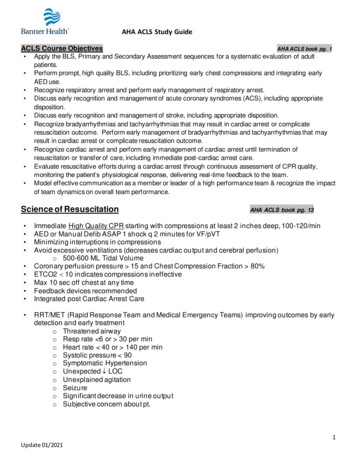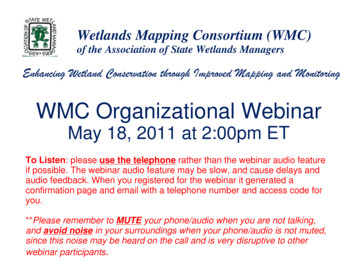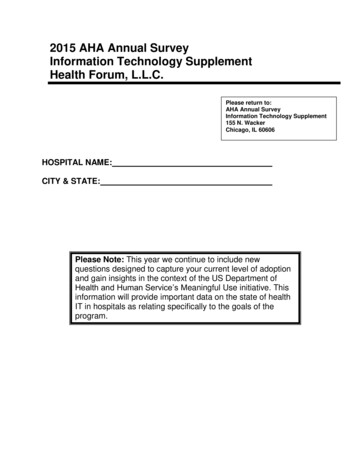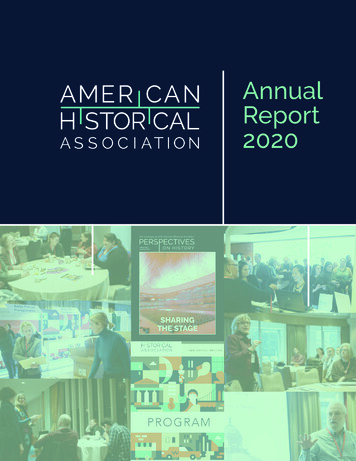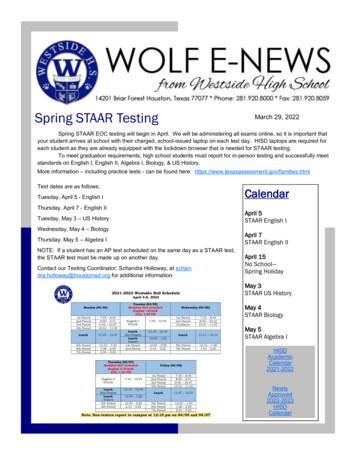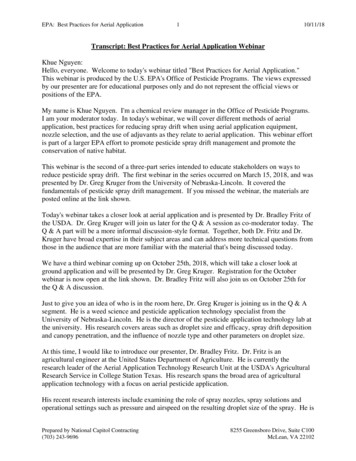
Transcription
Telehealth: Teams Transform Health CareJune 17, 2020
Rules of Engagement Audio for the webinar can be accessed in two ways:o Through the phone (*Please mute your computer speakers)o Or through your computer All hyperlinks on the screen are active if you click on them A Q&A session will be held at the end of the presentation Written questions are encouraged throughout the presentation and will be answered during theQ&A sessiono To submit a question, type it into the Chat Area and send it at any time during the presentation
Upcoming AHA Team Training EventsWebinarJuly 16, 2020 12:00 – 1:00 PM ESTRegister for the webinar Team Overboard: How to Get Your Team Back in the Boat Recognize the current state of their team’s engagement Identify at least two steps to help their team regain momentum Learn tools of resilience to prepare for the next challenge
New! Online Community Platform for AHA Team Training Access exclusive content andconversations you can't find anywhereelse Connect with other health careprofessionals who share similarsuccesses and challenges Share stories, tools, and content so wecan all become an expert team Find thought-provoking conversations,expert perspectives, and a littleJoin AHA Team Training’s Mighty Network today!inspiration each and every day
Today’s PresenterBarbara Edson, RN, MBA, MHAExec. Dir., Virtual Care CenterUNC Health
Today’s ObjectivesDiscuss key departmentsneeded to establish arobust telehealthprogramCompare in-personhealth care processes totelehealth health careprocessesExplain how toimplement in-patienttelehealth workflows
Virtual Care (VC) Context: Leveraging AHA Telehealth resources Language – so many terms! AHA attributes telehealth maturation/adoption AHA Telehealth Resourceshttps://www.aha.org/telehealthTables and toolso 7 Telehealth Use Caseso Specific Objective Achieved by Telehealtho Hospital Telehealth Maturity Model8
UNC Health Virtual Care Center (VCC) Program DevelopmentPre COVID-19 Foundationalo Strategic developmento Guiding principles Governance Structureo Complex - intentional Paceo Use case development &optimization Communication DashboardPost COVID-19 Governance StructureoStakeholder driveno Nimble Paceo Use case development &optimization Communication Dashboard9
What We Do Virtual Care Strategy: Work with HCS Leadership groups todevelop and refine HCS virtual care strategy Program Development: Define and build virtual care programsin line with HCS strategy, promote organizational learningVirtual CareStrategyOrganizationalLearning Implementation Project Management: Coordinate executionof virtual care projects and programs, establish standardizedtools, process and protocols Internal & External Communication: Build awareness of allvirtual care offerings Performance, Monitoring, Improvement & Sustainability:Develop metrics to monitor virtual care utilization, performance,improve and sustain programs Organizational Learning: Build system knowledge ofvirtual careProgramDevelopmentVCC COREFunctionsPerformanceMonitoring,Improvement rnal &ExternalCommunication10
It takes a TEAM: A broad team across the health care systemStakeholdersTechnology &EquipmentEnd-user groups – Voice of the customer Patients/Families – group yet to be developed Providers/Staff – stakeholder meetingOther Departmental StakeholdersEducation,Training &OperationalWorkflowsPatients Compliance Reimbursement & Risk Reporting, Data & Analytics Patient Engagement & Experience Marketing, Communication & Consumer Research Education, Training & Operational WorkflowsStaffMarketing ,Communication& ConsumerResearchVirtualCareProvidersFamilies Technology & EquipmentComplianceReimbursement& RiskReporting, Data& AnalyticsPatientEngagement &Experience11
Team Tools: Use in development of a VC program,products & services Team Structure – size membership, leaders, composition, etc. Leadership – coordinate activities of the team members by ensuring actions areunderstood, changes are shared, and team members have the needed resourceso Effective Team Leaders – Team goals, organize team, collective input of teammembers, empowered team members, skillful at conflict resolutiono Team Events – Brief, huddle and debrief Situation Monitoring – shared mental model, actively assessing the situationalelements to gain information, maintain awareness to support the functioning of the team. Communication – ability to clearly and accurately exchange information Mutual Support – ability to anticipate other team members needs through anunderstanding of responsibility and workload
VC Use Cases: Adapted from AHAProvider to Provider (P2P)Consults: eConsult (AMB / IP)Consults: PhoneTeleacute CareeICU, Telesitting, Telestroke, etc.Provider to Patient (DTC)eVisitVideo Visit: Scheduled (AMB)On-Demand(AMB)A/V Streaming (IP)Billable Telephone VisitMy UNC Chart MessagingRemote Patient MonitoringSecond Opinion
eConsults – Inpt & AMB settings Specific Epic@UNC referral type andprocess initiated by a provider who isrequesting specialty guidance in thediagnosis, management or treatmentof their patienteConsultP2P use caseTemplated communication between a requesting providerand responding providerEliminate low acuity/low value inoffice specialty referrals; improvetimeliness of patient careNo direct patient interaction; providerinitiated Several specialties are available forinpt & ambulatory eConsultsSpecialty and primary careproviders within UNC andcommunity providersNo audio/video; templatedcommunication between providers Provider and clinic operationalworkflow review and potential redesignrequiredNo incremental investment neededto scale/support technologyPeer-to-peer consult – sent tospecialty “eConsult In-Basket” forresponse less than 48 hoursTechnology ready; driven byprovider acceptanceOnly Medicare pays referring andconsulting providers; paid by timeand method. Self-pay option for allothers Provider education and trainingneeded Additional specialties continue to bebuilt in Epic@UNCEpic@UNC and Care LinkRisk provider acceptance andpotentially increasing cost of care14
eConsults TeamworkBroad team involved in development and implementation: DevelopmentooooProvider stakeholder group – voice of customerISD Team – technology build and optimizationCompliance, Reimbursement, Risk Team EducationEducation and TrainingooooLocal/facility championEducation, training and coaching supportCommunication and marketingData and analytics ImplementationPotential COVID application/benefit: Expand specialty access and increase turn-around time Diminish need for traditional Face to Face (F2F) consults for appropriate consults Reduce PPEP2P use case
Teamwork Tools – eConsult development / implementation Team Structure – Providers, ISD analyst (build) / developers and trainingo Workgroups involved – Technology and Equipment, Compliance, Reimbursementand Risk, Reporting and Analytics, Education/Training and Operational Workflowso Workgroups yet to be involved – Communication/Marketing and Patient Experience Leadership – Lead by an ambulatory and an inpatient group Situational Monitoring – Identified opportunities to optimize workflow Communication – General organizational communication, specific entity and role ofentity champion
Ambulatory Scheduled Video VisitsVideo Visit Nationally – largest increase of all virtualtools over 1000% increase Provider to patient (DTC) Epic@UNC embedded solutionooooBuilt using context aware-linkingScheduled in Epic@UNCPatient enters through patient portalSolution optimized over time Non-Epic embedded solutiono WebEx Teamso Other solutionsDTC use caseProvider completes full visit with patient via videoon-demand or scheduledProvide patient access for lowacuity or follow-up visits outsideof the traditional office setting Specialty & primary care providers,APPs Other professionals, LCSW, Caremanagers, PT, dietician, etc.Patient or provider driveninteractionAudio/videoDevelopment cost and minimaltechnologySolution Timing -scheduledTechnology ready; driven byprovider acceptanceReimbursement under COVID-19 EPIC@UNC embedded solutionusing context aware linking Non-Epic@UNC embeddedsolutionsValue achieved. Risk provider andpatient acceptance17
Ambulatory Scheduled Video Visits TeamworkDTC use caseBroad team involved in development and implementation: DevelopmentoooooProvider stakeholder group – voice of customerISD Team – technology build and optimizationCompliance, Reimbursement, Risk Team EducationEducation & TrainingCommunication Implementationo Originally piloted with small, group, with COVID-19 overwhelming demand, abrupt immense implementationo Education, training & coaching support on small scale, with COVID-19, resources needed to ramp up quicklyo Communication and marketing with smaller audience and infrequent, with COVID-19 frequent internal communicationwith large broad audiencePotential COVID application/benefit: Expand access Decrease unnecessary F2F appointments and decrease exposure risk
Teamwork Tools – Scheduled video visits development /implementationTeam Structure – Providers, ISD analyst (build)/developers and trainingooo Workgroups involved – Technology and Equipment, Compliance, Reimbursement and Risk, Reportingand Analytics, Education/Training and Operational WorkflowsWorkgroups yet to be involved – Communication/Marketing and Patient ExperiencePractice/Clinic TeamsRoles check-in/front deskRoles MA/ RNProviderPatientLeadership – Lead by ambulatory leaders and stakeholders,Situational Monitoring – Identified opportunities to optimize workflowCommunication – General organizational communication through established groups,communication to patients with COVID-19
Inpatient Virtual Solution: AVRounding and ConsultsDTC use caseDistal SiteOriginating SiteTelepresenter Provider to patient workflowPatient A team approach – What problem are youtrying to solve? Establishing a common goal Rounding and or consults Telepresenter needed or not? (requires staffresource) Internal or entity-to-entity Epic@UNC patient context linking embeddedsolution - Hyperspace, Haiku, Rover, Canto,MyChart Bedside or WebExTeams ISD & VCC meetings for operational planningDistal Site Deviceso Epic@UNC EmbeddedSolutionHyperspace, Haiku,Cantoo Non-Epic embedded solutionWebEx Teams withcomputerDX80Originating Site Deviceso Epic@UNC Embedded SolutionRover, Haiku, Canto, MyChartBedsideo Non-Epic embedded solutionWebEx Teams with computer,ipad20
Inpatient Virtual Solution TeamworkBroad team involved in development and implementation: DevelopmentoooooProvider stakeholder group – voice of customerISD Team – technology build and optimizationCompliance, Reimbursement, Risk Team EducationEducation & TrainingCommunication Implementationo Developed with COVID-19o Team – Operation and Providers key team for developmentPotential COVID application/benefit: Decrease exposure/decrease PPE use Ability for providers/care givers who are in quarantine to deliver care Access to specialty care providersDTC use case
Teamwork Tools – Scheduled video visits development /implementationTeam Structure – Providers, ISD analyst (build)/developers and trainingo Workgroups involved – Technology and Equipment, Compliance, Reimbursement and Risk,Reporting and Analytics, Education/Training and Operational Workflowso Implementation – a partnership Providers/Care Givers Telepresenters PatientLeadership – Lead by ambulatory leaders and stakeholdersSituational Monitoring – Identified opportunities to optimize workflowCommunication – General organizational communication through established groups,communication to patients/family members
Summaryo Opportunities exist to expand the team to include patients and familieso Opportunities exist to further develop existing teams and add structureo Virtual Care will continue to grow and evolve, predictions it will never return topre-COVID-19 stateo Teamwork tools can and should be employed in the development of a virtual careprogramo Teamwork tools are applicable in clinical virtual care delivery and require an expandedteam to deliver care
Questions? Stay in Touch!www.aha.org/teamtrainingEmail: teamtraining@aha.org Phone: (312) 422-2609
Team Structure - size membership, leaders, composition, etc. Leadership - coordinate activities of the team members by ensuring actions are understood, changes are shared, and team members have the needed resources o Effective Team Leaders - Team goals, organize team, collective input of team
